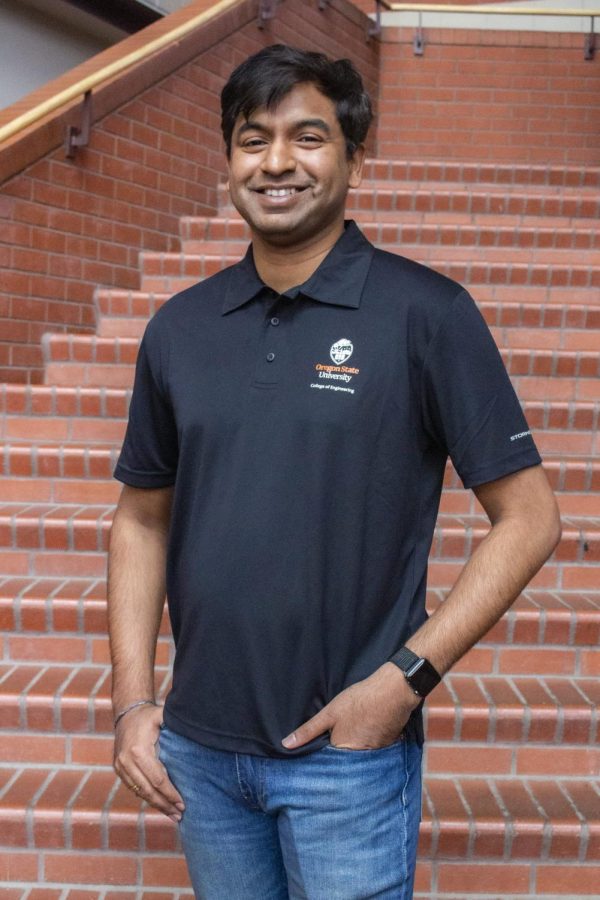OSU receives federal grant to reduce industrial carbon dioxide emissions
Researcher Dr. Pavan Akula (he/him) poses for a photo on March 24 on Oregon State University’s campus in Corvallis. A $540,000 grant was awarded to Dr. Akula and his team that would span three years, awarded upon proposal of a new carbon sequestration method.
April 10, 2023
Oregon State University has received a $540,000 grant from the U.S. Department of Energy to reduce the carbon footprint of the construction industry by sequestering carbon within cement.
The grant will span three years of research and was awarded to Pavan Akula of OSU and his partners from Sandia National Laboratory in India.
This comes after preliminary research in their proposal introduced a method to capture and trap carbon dioxide emitted by industrial processes within 3D-printed cement.
“Improving sustainability is quite important for the construction industry moving forward,” said Akula, an associate professor in the College of Engineering. “It’s associated with almost 13% of the global CO2 emission.”
Even though 3D printing cement requires less manual labor and has proven to be more efficient than conventional processes, it still uses Portland cement, the primary construction material in most countries, which yields high CO2 emissions when manufactured, Akula said.
“This process that we are trying to develop with Sandia and the partners in India is to look at capturing some of the CO2 and trapping it into the concrete that we are making now,” Akula said. “Here we are trying to reduce the amount of CO2 footprint of that 3D printable material by plugging in some of the CO2 back into the material.”
Akula, along with researchers from Sandia, the Indian Institute of Science and the Indian Institute of Technology Roorkee, will work together to create cement mixtures that are both sustainable and viable mixtures that can be scaled-up for construction, as two industry partners, Graymont and Verdant Building Alternatives, will provide feedback on sample mixtures made during the research project.
The international partnership was a proposal submission requirement by the Accelerating Carbon Capture and Storage Technologies Consortium, which approved funding for this research project, along with five others. Akula said that each research partner has a unique skillset.
“OSU will do most of the mixture design for 3D printing and carbon sequestration — we’re doing some heavy lifting here,” Akula said.
The carbon-sequestered samples will then be sent to Sandia, and the researchers there will test whether or not they have reasonable engineering properties.
Though the research is still in the development stage — with the project officially set to begin May 1 — preliminary data used in the proposal and accredited to recent OSU graduate Jaxon Moore was promising enough to receive the federal grant.
Moore, who completed his master’s degree in civil engineering at OSU in fall 2022, said he’s “really excited” that Akula received this grant.
“I’m really happy for Dr. Akula,” Moore said. “If this research does prove to yield significant results, then… it’s going to be a good way to kind of make your mark on the world, right?”
Moore said that Akula had presented the idea of recapturing CO2 from the high-emission processes of manufacturing lime, an industrial product, from limestone. Moore would work on and later defend this research for his master’s thesis.
“Dr. Akula came to OSU at the early part of my second year, and he had done some work with lime, and he had done some work with carbon sequestration of cementitious materials,” Moore said. “He kind of had this thought of: ‘Hey, can we combine the two?’”
Moore said he was lucky enough to be the student Akula chose to work with.
“In general, OSU is fostering a lot of creativity among the professors,” Moore said.
This creativity is reflected in Akula’s ambition to trap other, locally-sourced waste material into 3D printable cement mixtures as well, which may lead to a unique cement mixture tailored to Oregon.
“The Indian partners will be looking at adding fly ash to their mixtures and sequestering them, and here we’ll be looking at locally-available products, for example, slag from the steel plants and sequestering them,” Akula said. “Both of us will be working on a set of materials that are common, but then eventually we’ll look at adding certain additives that are locally-sourced.”
Matt Evans, an OSU professor of geotechnical engineering, said that significant time, effort and money has been spent by the geotechnical engineering faculty, school of civil and construction engineering and college of engineering over the past decade to provide facilities to support research like Akula’s.
“Our combination of facilities, faculty expertise, and excellent students makes us an attractive collaborator,” Evans said.
Though Akula aims to create a viable product that can be scaled-up and used in the U.S. and India, he said it is up to the industrial industry to adapt to a more sustainable cement mixture.
“At the end of the day, if you need to capture your CO2, (the industry) has to make some investments in changing how they do that,” Akula said. “We’ll propose the solutions, we’ll publish everything and then it’s up to the industry to adopt it or not.
Akula will be carrying out this research at the civil and construction engineering research lab in Graf Hall, and will be looking for two undergraduates in the beginning of spring term 2023 to assist him with the research.











































































































